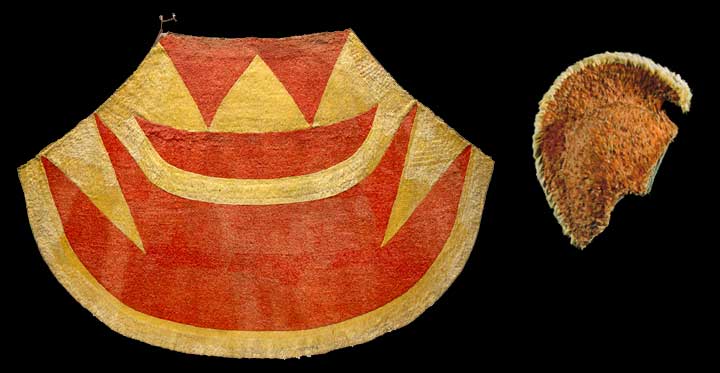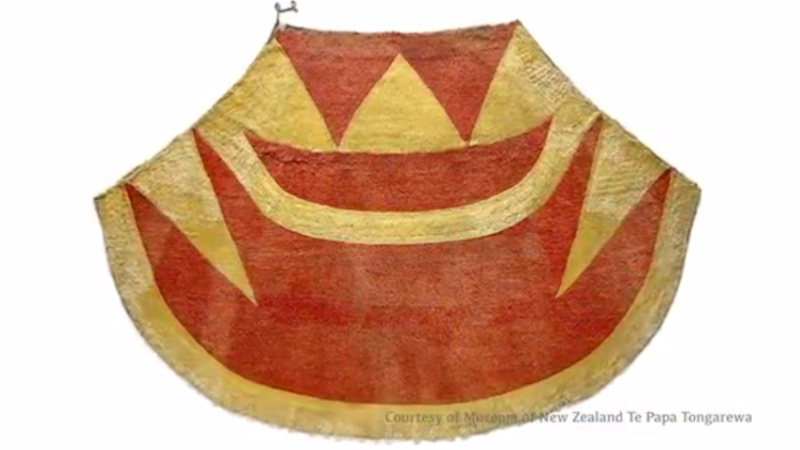If you’re planning on studying-up on your Hawaii history before you visit, you’ll likely come across the name, Captain James Cook. By becoming the first Westerner to arrive in Hawaii in 1779, he effectively changed the course of history for Hawaii as we know it. Pretty important guy, eh?
After this historic landing, Chief Kalaniopuu (the chief of Hawaii Island at the time) gifted the ahu ula (feathered cloak) and mahiole (feathered helmet) he was wearing to Captain Cook as a gesture of goodwill. But, when Captain Cook returned about a month later, things didn’t go as well, and a violent clash resulted in his death.
So, what happened to the ahu ula and mahiole? Turns out, they were left on Captain Cook’s ship during the incident, taken back to England, and passed through the hands of various museum owners and collectors. Eventually, they came under the care of a museum in New Zealand.
But now, they’re both on display at the Bishop Museum on Oahu, and you have the chance to see both of them together in Hawaii for the first time since they left its shores on Captain Cook’s ship 237 years ago.
“We are thrilled and honored to be able to return these treasures home to Hawaii, and into the care of the Bishop Museum,” said Rick Ellis, chief executive of Te Papa Tongarewa, the National Museum of New Zealand. “When they are shared with the people of Hawaii, I am sure they will inspire some wonderful conversations and insights, as they did when displayed here in Aotearoa New Zealand.”
The feathered cloak and helmet have great extrinsic value, but more importantly, they possess great intrinsic and spiritual significance. For Native Hawaiians, the ahu ula, mahiole, and all other featherwork were reserved exclusively for the use of their alii (royalty), symbolizing their chiefly divinity, rank and power. It embodied the life essence of a thriving abundant environment which are the telltale signs of leadership, as it takes a healthy forest ecosystem to produce enough bird feathers and cordage to make these regal pieces. From a historical perspective, the artifacts represent a period in the timeline of Hawaii when there was a balance between the cultural, political and spiritual parts of Native Hawaiians and the environment.
This ahu ula in particular has feathers from about 20,000 birds. The trappers often harvested only a few feathers from each bird before releasing them back into the wild so they could produce more feathers. Skilled workers belonging to the alii class crafted the olona cordage backing, a netting used as the foundation for the cloak, onto which the bundles of feathers were attached, creating bold designs.
“I’m grateful to witness the return of these cultural heirlooms, and how it is being made possible by the kōkua of many in both New Zealand and Hawaii,” said Kamanaopono Crabbe, Ka Pouhana of the Office of Hawaiian Affairs. “The return of the ahu ula and mahiole to Hawaii is a cause for celebration and it will be a source of inspiration, reflection and discussion amongst Native Hawaiians, Hawaii residents and visitors alike.”
The ahu ula and mahiole of Kalaniopuu will then be on long-term loan from Te Papa Tongarewa for at least 10 years.
“The ahu ula and mahiole left their homeland at the end of the season of Lono in 1779 and the memory they hold in their very fiber is that of a healthy, abundant, sovereign society,” said Mehanaokala Hind, director of community engagement with the Office of Hawaiian Affairs, and a lineal descendant of Kalaniopuu. “They will be returning home to the Hawaiian archipelago in that same season of the year 237 years later, at a time when Native Hawaiians are making strides in the health and well-being of our people. They will serve as a physical reminder to help guide Native Hawaiians in their pursuit of a thriving society.”
The items are a reminder of the generosity of the Hawaiian people when Westerners first arrived — and the fate of Captain Cook soon after. So, after a morning of kayaking, surfing, or paddle boarding in Waikiki, dry-off with a Hawaii history lesson right around the corner.






